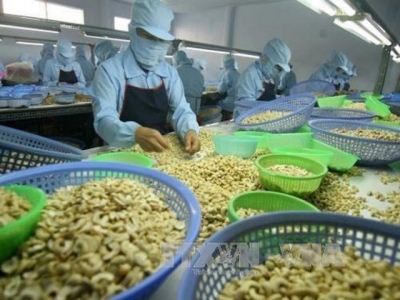Bình Phước cashew GI certified, aims to create national brand

Bình Phước Province has received a geographical indication certificate for its cashew from the National Office of Intellectual Property, and plans to develop a national brand for the product.—VNA/VNS Photo
BÌNH PHƯỚC – The grant of geographical indication (GI) certificate to Bình Phước Province’s speciality cashew by the National Office of Intellectual Property has been a strong boost to efforts to create a national brand for the product.
According to Nguyễn Văn Lợi, secretary of the Bình Phước Party Committee, cashew has been cultivated in the province for more than 40 years and has become a “poverty eradicator” by enriching locals, especially ethnic groups living in mountainous areas like the Stiêng and Khmer.
Getting the GI certificate would be of great benefit to local cashew products, he said, pointing out it would help build a brand for the nut and enhance export of products to markets that demand clear origin.
The geographical indication encompasses raw cashew, kernels, and roasted and salted nuts.
The raw cashew nut grown in Bình Phước is firm and dense, 14.5-18mm thick, and has a marketable kernel that is at least 30 per cent of its weight. Each nut weighs 5-6 grammes, meaning a kilogramme has less than 200 nuts.
Roasted and salted cashew nuts are of two types -- with and without the inner skin -- but without salt in the middle. The fat and carbohydrate content are at least 43 per cent and 23 per cent. The high fat and carbohydrate rates contribute to the nuts’ sweet, fatty taste.
The cashew grown here is unique thanks to the province’s geographical features which are suitable for growing the crop and the accumulated experience of locals in planting, caring for and harvesting it.
The province, dubbed the country’s cashew capital, now has more than 134,000ha under the nut and produces around 150,000 tonnes annually.
It has 200 companies and 400 small businesses specialising in cashew processing.
The province has 75,000 households, mostly ethnic minority, whose main income comes from cashew.
The Government plans to make Bình Phước the country’s main cashew-growing area by expanding the area under the crop to 200,000ha by 2020 and building a national brand for the nut.
The province exports cashew products to 25 countries and territories.
Related news
 Vietnam looks to China for Chi Lang custard apple exports
Vietnam looks to China for Chi Lang custard apple exports Chi Lang District in the northern mountainous province of Lang Son is renowned for its high quality custard apple, with growers seeking to increase domestic
 Vietnamese rice has more opportunities to enter the US
Vietnamese rice has more opportunities to enter the US Several US importers have added rice to the list of product items they will buy from Vietnam.
 Seminar discusses organic fruit cultivation
Seminar discusses organic fruit cultivation Organic practice in fruit cultivation was the highlight of a seminar held in the southern province of Tay Ninh on September 26.
 Mekong Delta develops beef, dairy farming
Mekong Delta develops beef, dairy farming Many provinces in the Cửu Long (Mekong) Delta have developed dairy and beef farming since it provides farmers with an additional income and benefits from local
 Indian rice prices slip on weak African demand; strong baht hurts Thai exports
Indian rice prices slip on weak African demand; strong baht hurts Thai exports Indian rice export prices slipped this week as demand from Africa was subdued, while shipments from Thailand remained sluggish due to a strong baht.